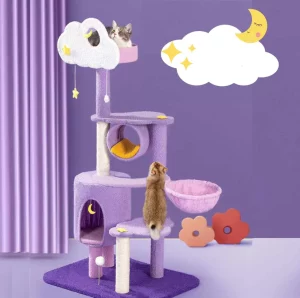What Are Cat Scratching Posts Made Of?
Cat Scratching Posts Made Of
If you have cats, you’ve probably noticed that they love to scratch. They do this because they want to mark their territory and relieve stress by stretching out their front legs and claws. You may have tried to prevent them from scratching the couch or carpet by moving their favorite spot to a more appropriate location, but this only works temporarily and can actually encourage them to scratch elsewhere. That’s why you need to have an effective cat scratching post that they can use reliably. A good scratching post is made of a material that feels satisfying to the cat when she scratches it and that will hold up for a long time.
Most cat scratching post are made of a piece of wood bound with sisal or another rough surface. They are usually mounted vertically in a wide base, which provides stability and makes them easier for a cat to stretch upward on her hind legs and place her front feet against as she scratches.

The surface of the post itself can vary, but most cats prefer one that is covered in a material similar to tree bark, which is the preferred scratching substrate in the wild for many cat breeds. Depending on your preference and the type of scratching post you have, you can also buy or make ones that are horizontal instead of vertical, which is helpful if your cat prefers to stretch out horizontally.
What Are Cat Scratching Posts Made Of?
It’s important for a scratching post to have a very rough, durable surface that resembles the rough texture of trees and other natural surfaces. This is what cats prefer and it’s the most likely to entice them to scratch. It is also better than a soft, smooth surface that can be more difficult for a cat to scratch because it can cause her claws to dig in and tear the soft fibers of the material.
While some people make their own cat scratching posts using materials like carpet, this is not a great idea because cats may find the same material in other areas of their homes and may have difficulty distinguishing between items they are allowed to scratch and those they should not. A good alternative to carpet is sisal fabric, which is typically woven from the agave sisalana plant, making it an environmentally sustainable option and one that feels satisfying for a cat to scratch.
Whatever you choose for your cat’s scratching post, it’s best to have more than one. This will allow your cats to take turns and also discourage them from scratching each other’s posts or other objects in the home. This will also help to train your cats to use their respective posts and avoid scratching furniture or other surfaces that you would prefer they not scratch. You can also create a perch pad to go with your scratching post to give your cats additional climbing and resting spots. You can even attach one of these to a wall so your cat can scratch and climb without having to leave her post or climbing structure.